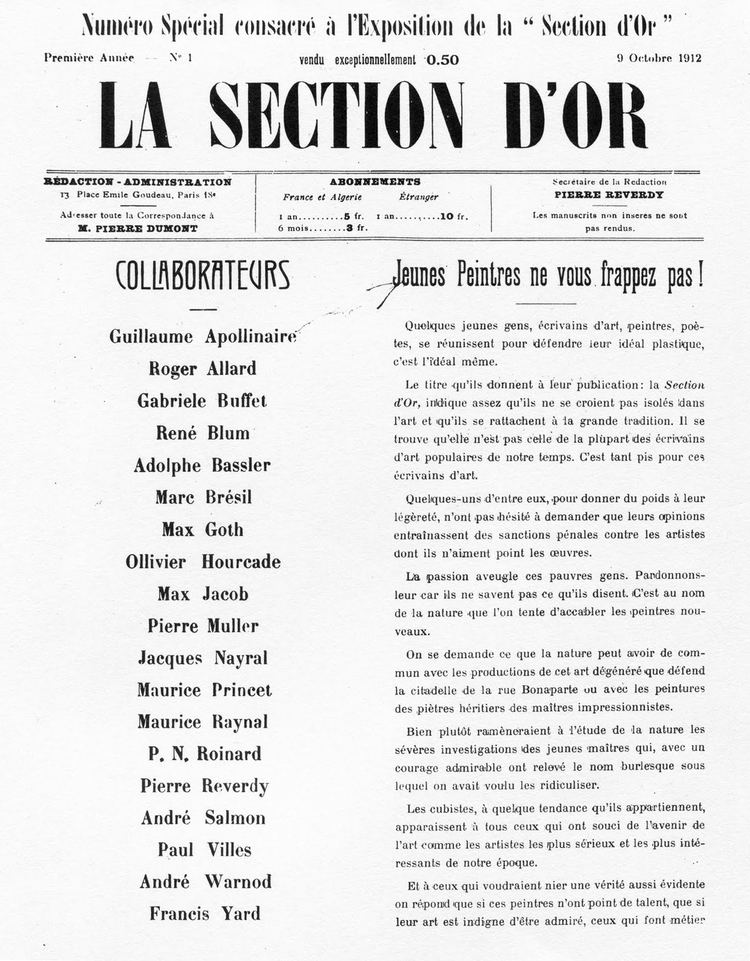 | ||
The Section d'Or ("Golden Section"), also known as Groupe de Puteaux (or Puteaux Group), was a collective of painters, sculptors, poets and critics associated with Cubism and Orphism. Based in the Parisian suburbs, the group held regular meetings at the home of the Duchamp brothers in Puteaux and at the studio of Albert Gleizes in Courbevoie. Active from 1911 to around 1914, members of the collective came to prominence in the wake of their controversial showing at the Salon des Indépendants in the spring of 1911. This showing by Albert Gleizes, Jean Metzinger, Robert Delaunay, Henri le Fauconnier, Fernand Léger and Marie Laurencin (at the request of Apollinaire), created a scandal that brought Cubism to the attention of the general public for the first time.
Contents
- History
- Salon de la Section dOr 1912
- Origins of the term
- Homage to Seurat
- Section dOr 1920 1925
- References
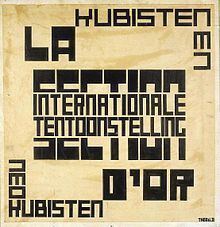
The Salon de la Section d'Or, held October 1912—the largest and most important public showing of Cubist works prior to World War I—exposed Cubism to a wider audience still. After the war, with support given by the dealer Léonce Rosenberg, Cubism returned to the front line of Parisian artistic activity. Various elements of the Groupe de Puteaux would mount two more large-scale Section d'Or exhibitions, in 1920 and in 1925, with the goal of revealing the complete process of transformation and renewal that had transpired since the onset of Cubism.
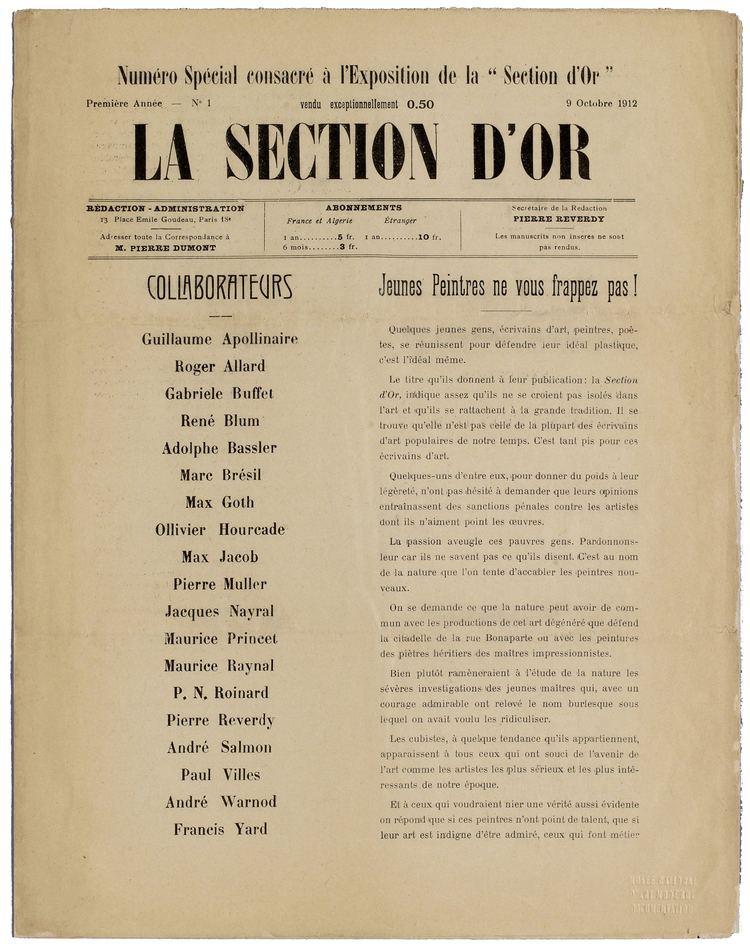
The group seems to have adopted the name "Section d'Or" as both an homage to the mathematical harmony associated with Georges Seurat, and to distinguish themselves from the narrower style of Cubism developed in parallel by Pablo Picasso and Georges Braque in the Montmartre quarter of Paris. In addition, the name was to highlight that Cubism, rather than being an isolated art-form, represented the continuation of a grand tradition: indeed, the golden ratio, or golden section (French: Section d'Or) had fascinated Western intellectuals of diverse interests for at least 2,400 years.

History
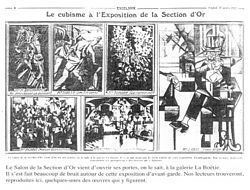
The Puteaux Group (an offshoot of la Société Normande de Peinture Moderne) organized their first exhibition under the name Salon de la Section d'Or at the Galerie La Boétie in Paris, October 1912. Albert Gleizes and Jean Metzinger, in preparation for the Salon de la Section d'Or, published a major defense of Cubism, resulting in the first theoretical essay on the new movement, entitled Du "Cubisme" (published by Eugène Figuière in 1912, translated to English and Russian in 1913).
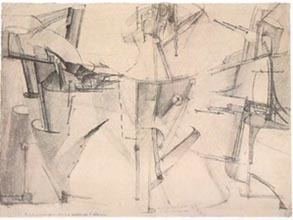
Following the 1911 Salon exhibitions the group formed by Le Fauconnier, Metzinger, Gleizes, Léger and R. Delaunay expanded to include several other artists; Alexander Archipenko, Joseph Csaky, Roger de La Fresnaye, Juan Gris, and Jean Marchand, who were virtually unknown to the public before the Salon des Indépendants of 1911, began to frequent Puteaux and Courbevoie. František Kupka had lived in Puteaux for several years in the same complex as Jacques Villon. Francis Picabia was introduced to the circle, perhaps by Guillaume Apollinaire (usually accompanied by Marie Laurencin) with whom he had recently become friendly. Most importantly was the contact established with Metzinger and the Duchamp brothers, who exhibited under the names of Jacques Villon, Marcel Duchamp and Duchamp-Villon. The opening address was given by Apollinaire. The participation of many of these artists in the formation of Les Artistes de Passy in October 1912 was an attempt to transform the Passy district of Paris into yet another art-centre; a further sign of a growing emphasis on communal activity that would culminate in the Section d'Or exhibit.
Salon de la Section d'Or, 1912
The 1912 Salon de la Section d'Or was arguably the most important pre-World War I Cubist exhibition. In the previous year the Cubists and a large number of their associates had exhibited at the Galerie de l'Art Contemporain (rue Tronchet, Paris) under the auspices of the Société Normande de Peinture Moderne. This exhibition had received some attention in the press (l'Autorité and Paris Journal), though due to the diversity of the works presented it had been referred to as an exposition des fauves et cubistes. The Salon de la Section d'Or, however, was generally accepted as being entirely Cubist in nature. Over 200 works were displayed, and the fact that many of the artists showed artworks representative of their development from 1909 to 1912 gave the exhibition the allure of a Cubist retrospective.
Though the Salle 41 Cubists had been surprised by the highly impassioned reactions generated by the 1911 Salon des Indépendants showing, they appear to have been eager to attract as much attention as possible with the Salon de la Section d'Or. The inauguration was held from nine until midnight, for which the only precedent was the opening of the 1903 Salon d'Automne. Invitations were widely diffused prior to the show, and many of the guests had to be turned away on opening night (9 October 1912). Lectures by Apollinaire, Hourcade and Raynal were advertised, and a review, La Section d'Or, was published to coincide with the Vernissage; with contributions by Guillaume Apollinaire, Roger Allard, René Blum, Olivier Hourcade, Max Jacob, Maurice Raynal, Pierre Reverdy, André Salmon, André Warnod and others.
The fact that the 1912 exhibition had been curated to show the successive stages through which Cubism had transited, and that Du "Cubisme" had been published for the occasion, indicates the artists' intention of making their work comprehensible to a wide audience (art critics, art collectors, art dealers and the general public). Undoubtedly, due to the great success of the exhibition, Cubism became recognized as a tendency, genre or style in art with a specific common philosophy or goal: a new avant-garde movement.
Origins of the term
The idea of the Section d'Or originated in the course of conversations between Gleizes, Metzinger and Jacques Villon. The group's title was suggested by Villon, after reading a 1910 translation of Leonardo da Vinci's Trattato della Pittura by Joséphin Péladan. Peladan attached great mystical significance to the golden section (French: Section d'Or), and other similar geometric configurations. For Villon, this symbolized his belief in order and the significance of mathematical proportions, because it reflected patterns and relationships occurring in nature. Jean Metzinger and the Duchamp brothers were passionately interested in mathematics. Jean Metzinger, Juan Gris and possibly Marcel Duchamp at this time were associates of Maurice Princet, an amateur mathematician credited for introducing profound and rational scientific arguments into Cubist discussions. The name La Section d'Or represented simultaneously a continuity with past traditions and current trends in related fields, while leaving open future developments in the arts.
Art historian Daniel Robbins argued that in addition to referencing the mathematical golden section, the term associated with the Salon Cubists also refers to the name of the earlier Bandeaux d'Or group, with which Albert Gleizes and other former members of the Abbaye de Créteil deeply involved.
Homage to Seurat
The Section d'Or group founded by some of the most prominent Cubists was in effect an homage to Georges Seurat. Within the works by Seurat—of cafés, cabarets and concerts, of which the avant-garde were fond—the Cubists' rediscovered an underlying mathematical harmony: one that could easily be transformed into mobile, dynamical configurations. Whereas Cézanne had been influential to the development of Cubism between 1908 and 1911, during its most expressionistic phase, the work of Seurat would attract attention from the Cubists and Futurists between 1911 and 1914, when flatter geometric structures were being produced. What the Cubists found attractive, according to Apollinaire, was the manner in which Seurat asserted an absolute "scientific clarity of conception." The Cubists observed in his mathematical harmonies, geometric structuring of motion and form, the primacy of idea over nature (something the Symbolists had recognized). In their eyes, Seurat had "taken a fundamental step toward Cubism by restoring intellect and order to art, after Impressionism had denied them" (Robert Herbert, 1968).
Section d'Or, 1920, 1925
After World War I, with the support given by the dealer Léonce Rosenberg, Cubism returned as a central issue for artists. With the Salons dominated by a return to classicism, Albert Gleizes attempted to resuscitate the spirit of the Section d'Or in 1920 but was met with great difficulty, despite support by Fernand Léger, Alexander Archipenko, Georges Braque, Constantin Brâncuși, Henri Laurens, Jacques Villon, Raymond Duchamp-Villon, Louis Marcoussis and Léopold Survage. Gleizes' organizational efforts were directed towards the re-establishment of a European-wide movement of Cubist and abstract art in the form of a large traveling exhibition; the Exposition de la Section d’Or.
The idea was to bring together a collection of works that revealed the complete process of transformation and renewal that had taken place. It was not the success he had hoped for. Cubism was seen as passé for emerging artists and other established artists such as Marcel Duchamp and Picabia, although Gleizes, on the contrary, felt that only its preliminary phase had been investigated.
In addition to Cubists works (which already represented a wide variety of styles), the second edition of the Section d'Or held at the Galerie La Boétie from 5 March 1920 included De Stijl, Bauhaus, Constructivism and Futurism. It was the revival of the Section d'Or which ensured that Cubism in general would become Dada's preferred target. The new polemic resulted in the publication of Du cubisme et des moyens de le comprendre by Albert Gleizes, followed in 1922 by La Peinture et ses lois.
